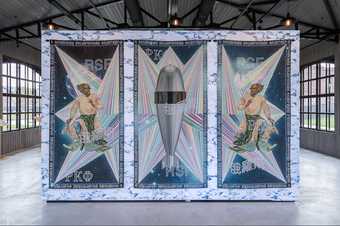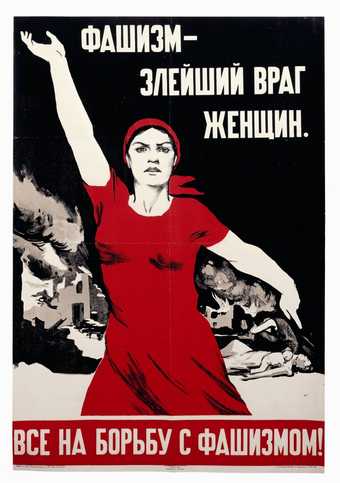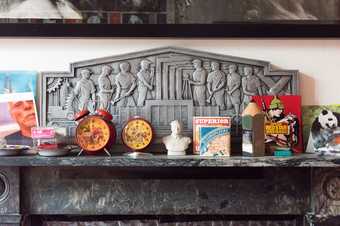
Mantlepiece in ground floor study. Photograph of David King (far left), his book Red Star Over Russia and an image of a panda, his favourite animal (far right)
Red Star Over Russia is in many ways an insight into the life of writer, photographer and graphic designer David King. His passion for Soviet visual history caused him to amass 250,000 objects - easily one of the world's largest collections of photography, art and graphics on this subject. This material became the fabric of King's life and home; a source ongoing fascination for him.

David King in Moscow, November 1977
The collection began in 1970 when King was working as art editor of The Sunday Times Magazine. Sent to Russia to bring back images for a special feature on the revolutionary Leon Trotsky, King found that all record of this man had been obliterated. His initial search for Trotsky imagery soon expanded to encompass all Soviet visual culture; threads of one narrative weaving inseparably into the next. From the overthrow of the last Tsar and the revolutionary uprisings of 1917, through to the struggles of the Civil War and Stalin’s campaign of terror, King’s collection reveals how seismic political events led to the social transformation that inspired a wave of innovation in art and graphic design across the country.
Accompanied by photographs of where he lived, we hear some personal stories of how he gathered these objects:
As I write this, my top floor studio is in chaos. Thousands of Russian photographs and graphics, unused or about to be used [in my exhibition at Tate Modern], are piled high on trestle tables or scattered all over the floor … Up and down the stairs, boxes of even more photographs, fallen in the fray of frenetic decision making, wait in vain to be re-filed … It has taken me four decades to assemble the 250,000 artifacts in the collection …
So here are some notes, anecdotes and memories of how this chaos of collecting came about, documenting the vision of communism in a world of sleepless nights.
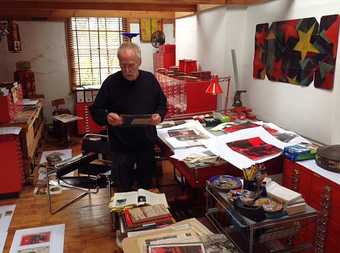
King working in his attic studio, December 2015
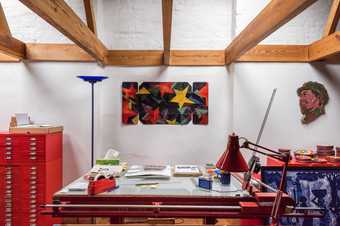
King's work table. Photographed with pages from his unfinished book Print and Revolution, the sequel to Red Star Over Russia
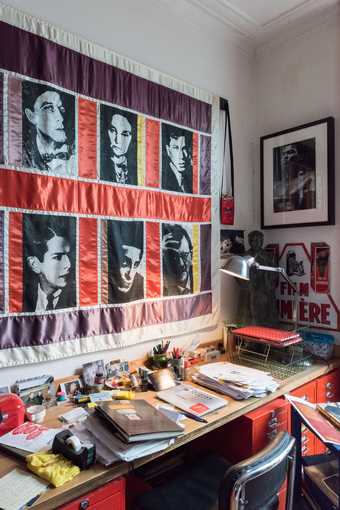
Ground floor study. Banner featuring King's favourite cultural figures including Vsevolod Meyerhold, Boris Pasternak and Dmitri Shostakovich (centre) and Muhammad Ali by King (far right)
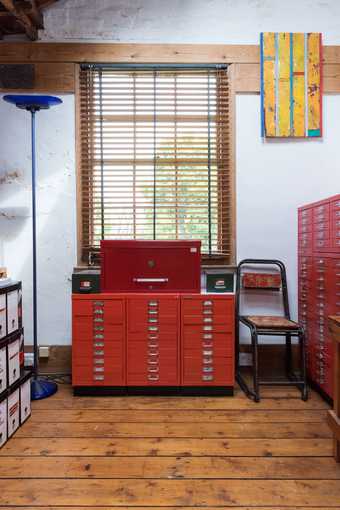
The attic studio. Red cabinets which stored King's photography and archive materials (centre) and painting by King (far right)
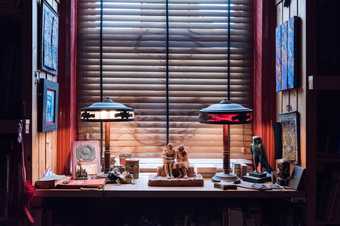
Library windowsill. Stalinist period lamps and sculpture by King's friend Judy Groves (centre). Painting by King (top right)
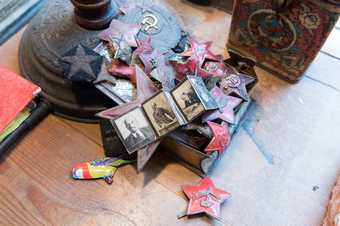
Red Army badges from the civil war. Badge is c.1919, distinguished by its rare plough and hammer symbol (bottom centre)
My great grandfather was my earliest link with Russia. He was an engineer for the Great Western Railway. They got the contract to build the Russian rail network in tsarist times … On the dresser in my grandmother’s kitchen there used to be a heavy lead cosh. When I was a child my father told me darkly that it has been issued to my great grandfather in Russia to beat off the wolves in the forests when he and his fellow railwaymen were constructing the lines.

Library with guestroom mezzanine. His collection of rare books included one from Stalin's personal collection with Stalin's own annotations
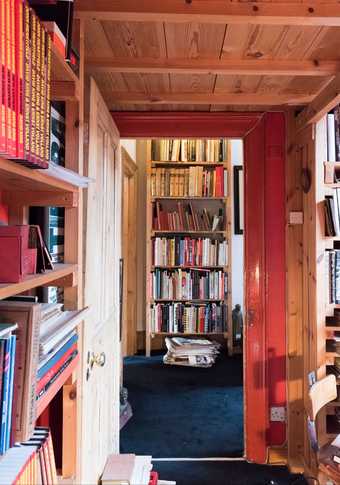
Library. All wooden floors, shelves and panelling where built and installed by King when he renovated the property in the 1960s
My first visit to the Soviet Union took place in the deep mid-winter of 1970. It was a particularly dark and snowbound February in Moscow and the temperature often plummeted to thirty below zero. Sometimes my Nikon F2 cameras would protest at the cold and freeze up and then I would have to return to the hotel and defrost them on the radiators for half an hour.
About to do this one evening, I opened the door to my room and interrupted someone leafing through my notebooks. It didn’t matter, I had nothing to hide and in a way was rather expecting it. He said sorry in English and left.

Kitchen. Sun Maid raisin packets and postcard of his favourite film Mulholland Drive. King used to eat Sun Maid raisins and then throw the empty packets above the sink
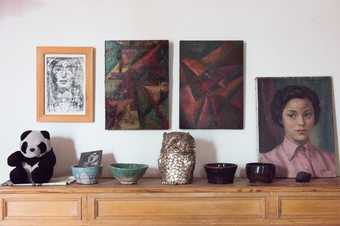
Front room. Toy panda (far left), two paintings by Judy Groves (centre) and a portrait of King's partner, Valerie Wade, aged 11 (far right)

Front room. Sculpture by David King (centre)
One day I had a phone call from [a Russian intellectual named] Masha. She needed some cash, wanted to sell some of her mother’s Russian revolutionary posters, was I interested? … When she opened the door I could see the house was a real mess, damp everywhere, What’s gone wrong? I asked. The roof, she replied.
The posters were good… I asked her what she and her mother wanted for them. She didn’t know. I said what’s the matter with the roof? It collapsed. So how much is a new roof? She told me. I said fine; give me the posters and I’ll pay for the roof ... She phoned me again a few weeks later; the builders had finished and the house was perfect.
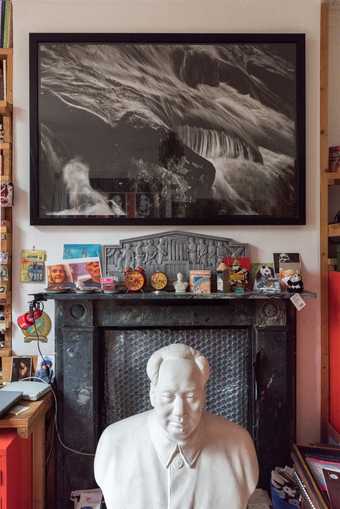
Ground floor study. Photograph by David King and bust of Chairman Mao (centre). King was also interested in the visual culture of other totalitarian regimes
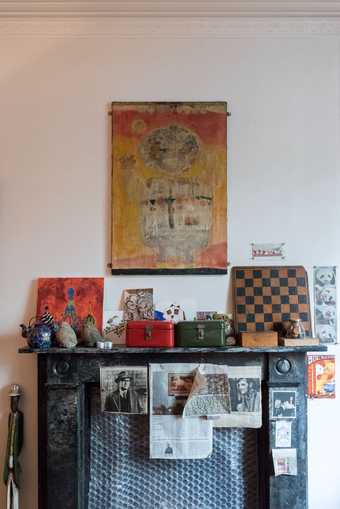
Kitchen. Featuring artworks gifted to King by friends and clippings of newspapers of interest
There used to be a famous socialist secondhand bookseller in Zurich. I visited his shop one day but was disappointed to find that it bore little relation to the interesting catalogues he had been publishing for years. I asked him where all his Russian material had gone. He replied, “Oh, that! … I think it’s in the basement …’
An iron spiral staircase led down into darkness; black on black … “So where are the photographs?” I asked, trying to hide my disappointment. “You are standing on them … they’ve been down here for years, nobody’s interested in them, take what you want.”
I looked down. The floor was covered with original Russian photographs from the 1920s and 30s …

Hallway. Paintings by his daughter Josephine King and books on the history of the Soviet Union, many with images licensed from King's library
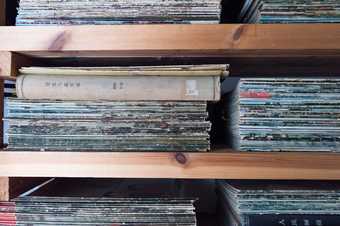
China Contemporary Magazine
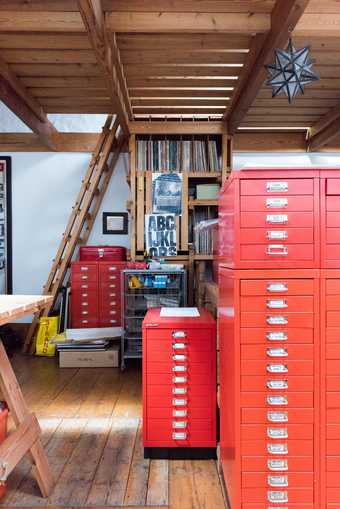
The attic studio. Featuring King's record collection, which includes vinyls by Maria Yudina
It was an offence under Soviet law, and still is, to import or export almost anything except the most innocuous souvenirs and gifts without official permission. All forms of printed matter and photography were felt to be particularly suspect at customs...
1984. The night before I left Leningrad I visited a photographer and his friend, a scientist... The evening ended. I was putting on my coat in the hall when the scientist came straight out with it: "I've got sixy one rolls of microfilm in this bag. It is a lifetime's scientific research and I can't get it published here. Will you take it to France for me?"
I gasped... "I can't customs will find it"... He was in tears "Please, here it is, you have to take it."
[At Leningrad airport] I was taken out of the passport queue and escorted into a side room. I started to think about the scientist.
Soon an exceptionally beautiful woman commissar hurriedly entered the room. "What have you got in your bags?"
"Nothing much... just photographs I've taken." I waited for trouble."What have you been doing here?"
"I have been researching the life of Maria Yudina, the great Russian pianist because I wish to publish a book on her in the West."
Now she lowered her voice "You know about Marushya? I love her. Have you got all her records?" Then she spoke quietly again: "Make a wonderful book on Marushya, please, make a wonderful book."Then she turned sharply to the gormless guards: "Let him through, he studies Yudina!"

Door mat with red stars. Floor boards built by King to meet its edges
King's partner, Valerie Wade, told us of his final days. Although comforted in the knowledge that he had secured a future for his work in Tate's collection, letting go of these precious items was hard. After a mild heart attack King discharged himself from hospital. 'I just want to sleep at home' he told Wade. For the last time, he rested amongst the handmade pine shelves and ordered scarlet cabinets which held the fruits of years of dedicated work. He died that night surrounded by his collection. He never had to see an empty shelf.
Photographed by Lucy Dawkins for Tate
All quotes are taken from Red Star Over Russia and Russian Revolutionary Posters by David King.

